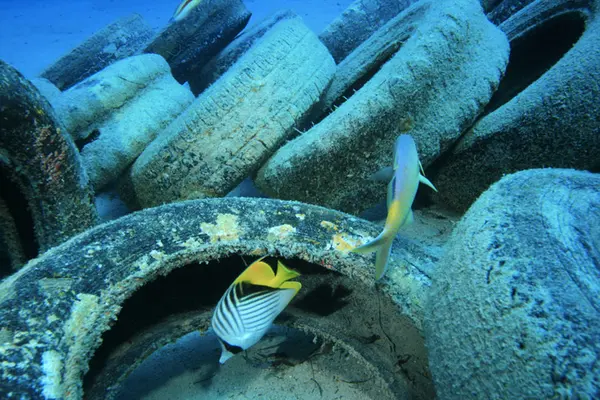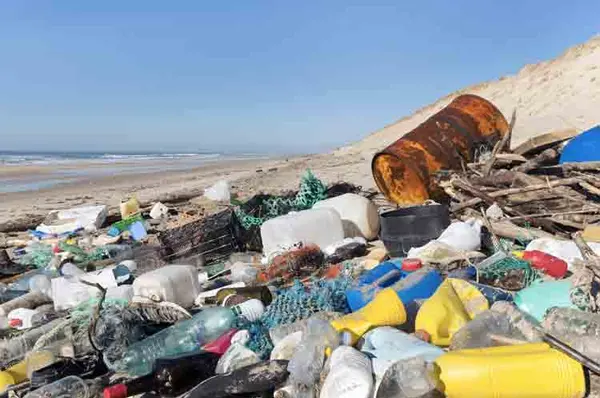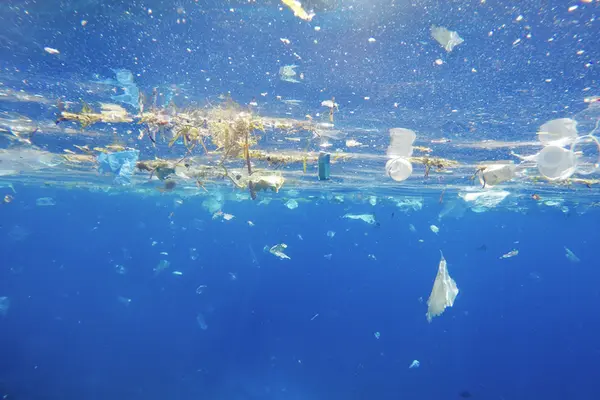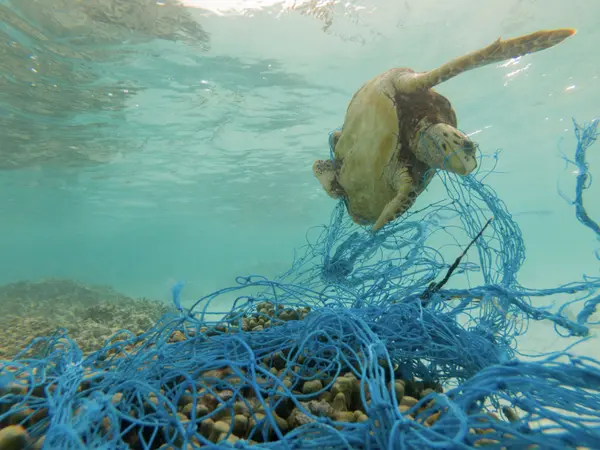Unspoilt nature, crystal-clear seas and an abundance of marine life — the reasons why sailing has truly captured our hearts. For us sailors, the ocean is simply the most beautiful and fundamental of elements. Unfortunately, the amount of plastic in the ocean is ever increasing. So, what can we do about it? The best place to start is with ourselves and not just to think about it on board a boat.
Of course, the problem isn't just about us sailors. The oceans and seas cover more than 70 % of our planet. They supply half our oxygen and absorb up to a third of the carbon dioxide.
They are home to millions of animals and a source of livelihood for countless people. Almost 2.4 billion people live within 100 kilometres of the coast. In the future, will our planet still be blue or just full of plastic? Can sailors make a difference?
 Car tyres dumped on a coral reef
Car tyres dumped on a coral reefIs plastic really a problem?
Each year, more than 8 million tonnes of plastic reach the ocean. According to recent research, this figure may be even higher — up to 14 million tonnes per year. This is equivalent to dumping a full truckload of plastic into the sea every single minute. To put this into context, imagine over 200 billion plastic bottles per year.
Each year, plastic waste kills up to a million seabirds, 100,000 marine mammals, sea turtles and untold numbers of fish. Plastics remain in the ecosystem for countless years and are harming marine animals every day.
Plastics account for up to 80 % of all waste in the seas. According to some estimates, at the rate plastic products are being discarded, by 2050 there will be more plastic in the sea than fish and an estimated 99 per cent of seabirds will have fragments of plastic in their bowels.
How does plastic waste reach the sea?
- 80 % of all sea pollution is a result of land-based activities. Asia accounts for more than 63 % of the plastics discarded — China produces more than a quarter, with Indonesia, the Philippines, Thailand and Vietnam also contributing heavily. The US is the highest-ranking developed nation.
- According to a German study, more than 90 % of the plastics that end up in the sea are brought there via ten large rivers flowing through densely populated areas. Eight of them are in Asia and the other two (the Nile and Niger) are in Africa. But the problem, albeit much smaller, is also from Europe. The Danube River alone annually collects and then releases approximately 1,700 tonnes of plastic into the sea.
- Plastic waste, however, can also get into the sea during a natural disaster. A study, published in the journal Scientific Reports estimates that the 2011 earthquake in Japan swept up to 20 per cent of the total amount of plastic waste into the sea.
 Garbage and waste on the beach
Garbage and waste on the beach How much plastic is actually floating in the ocean?
Since the invention of plastic, over 8 billion tonnes of it have been produced worldwide. At present, around 300 million tonnes of plastic are produced annually, 40 % of which is packaging (the forecast for 2020 is 400 million tonnes). However, recycling systems cannot keep pace with this growth in demand and the problem is compounded by the current cut in recycling by China.
Estimates suggest that only 9 % of plastic is recycled, another 12 % burned, and the remaining 79 % of plastic waste pollutes the environment. If the current trend continues, the Earth will have generated around 34 billion tonnes of plastic by 2050.
Determining exactly how much plastic waste is floating in the oceans is not easy and not even exactly possible. One frequently cited study from 2013 estimated the total amount of plastic in the sea to be only 269,000 tonnes. Oceanographer Marcus Erikson, along with a group of scientists, made 24 expeditions between 2007 and 2013. They collected data on key water currents and the amount and size of plastics. However, they only focused on plastics floating on the surface.
As a result, this number is far from accurate as it wasn’t possible to include waste that no longer floats. Such waste is even more dangerous. We also already know that 8 million tonnes of plastic are added every year. Where does the plastic go?
Where does plastic waste accumulate?
A total of 57 % of plastic waste is floating in the northern hemisphere. And most of it is in the northern Pacific. There lies the so-called Great Pacific garbage patch. But it isn’t the only one. There are six similar artificial islands floating in the world’s oceans. But mapping and chronicling them is almost impossible. Due to ocean currents, their shape, size, density and even location are constantly changing.
Similar patches of waste can also be found in the Atlantic and the Indian Ocean and are also beginning to appear in smaller areas, such as the North Sea, Greenland and the Barents Sea. According to estimates, 300 billion tiny pieces of plastic are currently floating in the Arctic. Atlantic Ocean currents carry the waste there mainly from North America and Europe.
 Plastic sea pollution
Plastic sea pollution Even the deepest depths and uninhabited virgin beaches are affected
Some other studies estimate that up to 70 % of plastic waste will end up on the seabed and in the ocean depths. Even at the deepest natural point on the planet, the Mariana Trench (nearly 11 km deep), researchers have found plastic bags. Unspoilt deserted bays are also not immune to plastics. In 2015, Jennifer Lavers, along with researchers from the Institute for Marine and Antarctic Studies (IMAS), discovered 18 tonnes of plastic waste on the uninhabited Henderson Island in the Pacific Ocean.
In fact, at one site, 672 pieces of waste per square metre were counted. Henderson Island is on the list of UNESCO protected areas and is uninhabited due to the lack of fresh water and so not directly impacted by human activity.
More articles about underwater life:
What kind of waste is most often found at sea?
The authors of the study, Plastic Pollution in the World's Oceans, recorded what waste ends up in the seas. Often they encountered roll-on deodorant balls, toothbrushes, buckets, bouncy balls, plastic bottles and beach footwear. Disposable plastic packaging is the most common item found on beaches. This includes drink bottles, straws, disposable shopping bags, sanitary towels, tampons, cotton earbuds, condoms, cigarette butts and disposable lighters.
Fishing equipment, so-called 'ghost nets', often end up in the seas. Forgotten, lost or otherwise discarded fishing equipment accounts for up to 10 per cent (640 thousand tonnes) of all marine waste.
In 2004, members of the GhostNets Australia project found and collected more than 13,000 lost fishing nets in an area north of Australia. A study published in the journal Conservative Biology shows that 4866 to 14,600 turtles were caught in these "ghost nets" in this area alone.
 Green sea turtle entangled in a discarded fishing net
Green sea turtle entangled in a discarded fishing net How does waste kill animals?
According to the UN, plastic waste kills up to one million seabirds, 100,000 marine mammals, sea turtles and countless fish every year. The internet has long been flooded with images of turtles gagging on plastic bags, and seahorses clutching cotton earbuds. And the evidence is mounting.
In the autumn of 2018, a dead cetacean washed up on a beach of the Indonesian island of Sulawesi had nearly 6 kg of plastic in their stomachs. Among other things are flip-flops, plastic bottles, shopping bags, more than a hundred disposable cups and thousands of plastic fragments.
- It is reported that more than 40% of the existing whale, dolphin and porpoise species, all sea turtle species and approximately 36 % of seabirds have ingested garbage in the sea. Afflicted animals have their stomach filled with plastic debris and then literally die of starvation.
- Fish, turtles, seabirds and mammals are captured in old fishing gear in so-called "unwanted catches." According to the non-profit organization World Animal Protection, this kills 100,000 whales, fish, seals, turtles and other sea life each year.
- Plastics in the water are also harmful in other ways. They act as a magnet for oily and dangerous substances, which poison the fish and subsequently the person whose plate they end up on.
- There are some chemical substances contained in plastics that act as a poison, weakening or killing marine animals. It can be carcinogenic or negatively affect reproductive organs, which further threatens the population of fish, birds and other animals.
- Floating waste can also serve to spread invasive species.
- In many areas, plastic concentrations are up to seven times higher than zooplankton concentrations, as demonstrated by research from Algalita, an independent California-based marine research institute.
Microplastics in the seas and oceans
But it's the plastics that are polluting the seas and oceans the most that are not visible. About 92 % of the more than five trillion pieces of plastic waste floating on the surface form so-called microplastics. These are tiny particles with a diameter of up to 5 millimetres. They are not only a serious problem at sea, they are also found in large quantities in drinking water.
The world's toughest race, the Volvo Ocean Race is a harmonious combination of sport, science and ecology. For several years now, a map of microplastics has been created directly during the race. In addition, the Ocean Race has also established some ground rules on how to tackle plastic in the seas and oceans — for example, no disposable plastic utensils may be used during the race, and only like-minded companies that are committed to sustainability and make every effort to reduce their plastic footprint can be race partners. In addition, the Ocean Race is creating a new generation of ocean conservationists through its educational challenge by helping children across the planet understand the issues that affect our marine world.
Microplastics are hidden in up to 80 % of tap water. But how do they get into the water supply? One possible way is by washing clothes that contain microfibres. These are such materials as fleece, nylon, waterproof fabrics and fabrics used to produce sportswear.
Time to change
The oceans are also battling a host of other major problems. Numerous toxic substances in the water threaten to cause irreversible damage to the balance of the ecosystem. An urgent problem is unregulated fishing and overfishing of some species. But the biggest threat to the ocean is undoubtedly climate change.
A number of non-profit organizations and projects are dedicated to marine conservation, education and awareness. National authorities and the international community are aware of the urgency of the problem and have been discussing possible measures.
 Paradise with a beautiful white sandy beach and tropical sea
Paradise with a beautiful white sandy beach and tropical sea What can sailors do to help?
Can sailors themselves make a difference? Surprisingly, very easily. Below we have a few simple tips for novices that won’t complicate life aboard a boat. Every step counts and these tips cost you almost nothing.
- Do not leave any plastic utensils or bags loose on the boat. They can easily blow away. If at all possible, avoid plastic on the boat altogether.
- Ideally, of course, it best not to produce waste at all. Choose packaging that doesn’t use single-use plastics, use cloth bags and shop locally in markets.
- Do not throw cigarette butts into the sea. Besides being plastic, the captured pollutants destroy corals.
- Sort your waste. Plan your stops at eco-friendly marinas where they handle waste responsibly.
- Don’t use sunscreen, which destroys coral. Replace with mineral-based creams, such as those containing zinc.
- Bring biodegradable, non-perfumed detergent on board. There are several highly effective ones on the market that can tackle even the greasiest of pots and pans.
- Try to buy bigger containers rather than small plastic (PET) bottles. They will fit comfortably in the locker and each crew member can fill their own bottle with fresh water.
- If you have kids with you or love cocktails, pack a stainless steel straw instead of plastic ones.
- Get involved in beach and ocean cleaning. Whether as part of a wider group or just on your own.
There are dozens of tips and tricks for waste-free and environmentally responsible behaviour, and most of them can be easily applied to sailing and boating. Gradually try more ecologically responsible steps, to help keep more fish in the ocean than plastic waste.
No matter what, you’ll be happy to see the impact of these efforts with your own eyes, whether it be clean white beaches or swimming and snorkelling in a crystal-clear turquoise sea.
